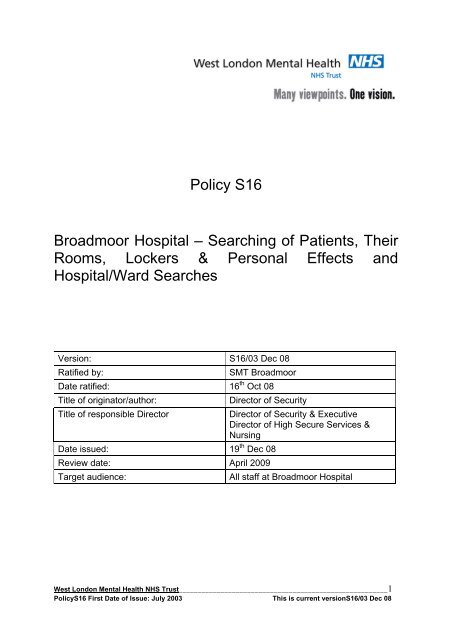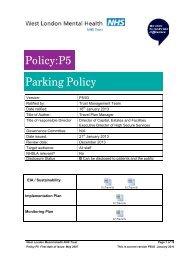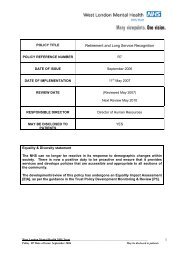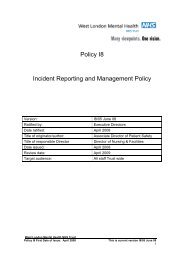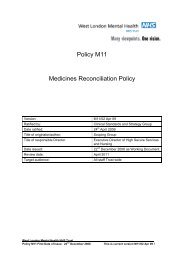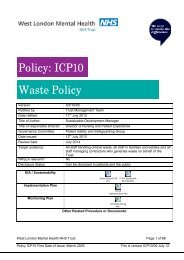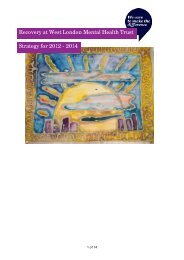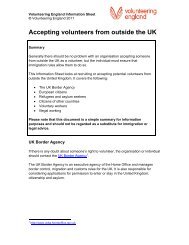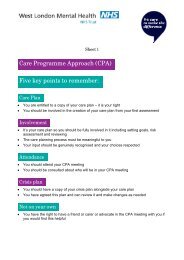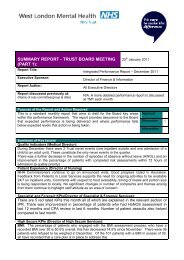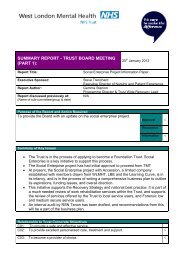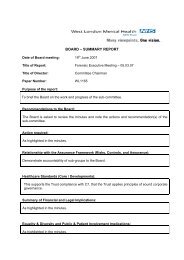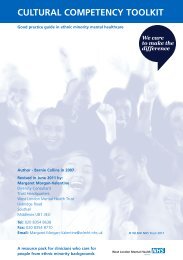Searching of Patients at Broadmoor Hospital - West London Mental ...
Searching of Patients at Broadmoor Hospital - West London Mental ...
Searching of Patients at Broadmoor Hospital - West London Mental ...
- No tags were found...
Create successful ePaper yourself
Turn your PDF publications into a flip-book with our unique Google optimized e-Paper software.
Policy S16<strong>Broadmoor</strong> <strong>Hospital</strong> – <strong>Searching</strong> <strong>of</strong> <strong>P<strong>at</strong>ients</strong>, TheirRooms, Lockers & Personal Effects and<strong>Hospital</strong>/Ward SearchesVersion: S16/03 Dec 08R<strong>at</strong>ified by:SMT <strong>Broadmoor</strong>D<strong>at</strong>e r<strong>at</strong>ified: 16 th Oct 08Title <strong>of</strong> origin<strong>at</strong>or/author:Director <strong>of</strong> SecurityTitle <strong>of</strong> responsible DirectorDirector <strong>of</strong> Security & ExecutiveDirector <strong>of</strong> High Secure Services &NursingD<strong>at</strong>e issued: 19 th Dec 08Review d<strong>at</strong>e: April 2009Target audience:All staff <strong>at</strong> <strong>Broadmoor</strong> <strong>Hospital</strong><strong>West</strong> <strong>London</strong> <strong>Mental</strong> Health NHS Trust_______________________________________________________1PolicyS16 First D<strong>at</strong>e <strong>of</strong> Issue: July 2003 This is current versionS16/03 Dec 08
POLICY TITLE<strong>Broadmoor</strong> <strong>Hospital</strong> – <strong>Searching</strong> <strong>of</strong> <strong>P<strong>at</strong>ients</strong>,Their Rooms, Lockers & Personal Effectsand <strong>Hospital</strong>/Ward SearchesPOLICY REFERENCENUMBERS16DATE OF IMPLEMENTATION 19 th December 2008DEVELOPED / REVIEWEDBYDirector <strong>of</strong> Security / Executive Director <strong>of</strong>High Secure Services & NursingDUE FOR NEXT REVIEW April 2009RESPONSIBLE DIRECTORExecutive Director <strong>of</strong> High Secure Services& NursingDISCLOSURE STATUS(B) Can be disclosed to p<strong>at</strong>ients and thepublicEquality & Diversity st<strong>at</strong>ementThe Trust aims to design and implement services, policies and measures th<strong>at</strong> meet thediverse needs <strong>of</strong> its services, popul<strong>at</strong>ion and workforce, ensuring th<strong>at</strong> none are placed <strong>at</strong> adisadvantage over others.The development/review <strong>of</strong> this policy has undergone an Equality Impact Assessment[EIA], as per the guidance in the Trust Policy Development Monitoring & Review [P3].<strong>West</strong> <strong>London</strong> <strong>Mental</strong> Health NHS Trust_______________________________________________________2PolicyS16 First D<strong>at</strong>e <strong>of</strong> Issue: July 2003 This is current versionS16/03 Dec 08
S16<strong>Broadmoor</strong> <strong>Hospital</strong> – <strong>Searching</strong> <strong>of</strong> <strong>P<strong>at</strong>ients</strong>, Their Rooms, Lockers& Personal Effects and <strong>Hospital</strong>/Ward SearchesVersion Control SheetVersion D<strong>at</strong>e Title <strong>of</strong> Author St<strong>at</strong>us CommentS16/01 July2003Director <strong>of</strong> ForensicServices and theDirector <strong>of</strong> SecurityNew Policy issuedS16/02 05.11.08 Director <strong>of</strong> Security Amendmentsmade to policyreview d<strong>at</strong>eS16/03 19.12.08 Director <strong>of</strong> Security Revised Policydissemin<strong>at</strong>ed tostaff<strong>Broadmoor</strong> SMTMeeting extendedreview d<strong>at</strong>e on 16Oct 2008 (seeminutes)<strong>West</strong> <strong>London</strong> <strong>Mental</strong> Health NHS Trust_______________________________________________________3PolicyS16 First D<strong>at</strong>e <strong>of</strong> Issue: July 2003 This is current versionS16/03 Dec 08
S16<strong>Broadmoor</strong> <strong>Hospital</strong> – <strong>Searching</strong> <strong>of</strong> <strong>P<strong>at</strong>ients</strong>, Their Rooms, Lockers& Personal Effects and <strong>Hospital</strong>/Ward SearchesContents1. Introduction2 Aims3 The Authority and Right to Search4 Respect for <strong>P<strong>at</strong>ients</strong>’ Privacy and Dignity5 <strong>P<strong>at</strong>ients</strong> Consent/Refusal to Cooper<strong>at</strong>e6 Escorting <strong>of</strong> <strong>P<strong>at</strong>ients</strong> – Items Allowed to be Carried7 Individual P<strong>at</strong>ient Searches8 Frequency <strong>of</strong> Personal Searches – (Level 1)9 Level 1 Search Procedure10 Level 2 Search Procedure11 Level 3 Search12 Ward/Departmental Searches13 Bedroom and Locker Search Procedure14 Specific Bedroom and Locker Search15 <strong>Hospital</strong> Searches16 Dealing with Items Found17 Search RecordsAppendicesAPPENDIX 1Level 1 Search Procedure – Male <strong>P<strong>at</strong>ients</strong>APPENDIX 2Level 1 Search Procedure – Female <strong>P<strong>at</strong>ients</strong><strong>West</strong> <strong>London</strong> <strong>Mental</strong> Health NHS Trust_______________________________________________________4PolicyS16 First D<strong>at</strong>e <strong>of</strong> Issue: July 2003 This is current versionS16/03 Dec 08
1 Introduction1.1 <strong>Broadmoor</strong> <strong>Hospital</strong> provides tre<strong>at</strong>ment and care for p<strong>at</strong>ients with a mental disorderunder conditions <strong>of</strong> high security on account <strong>of</strong> their dangerous, violent or criminalpropensities.1.2 We have a st<strong>at</strong>utory duty to provide a therapeutic and safe living and workingenvironment for p<strong>at</strong>ients and staff and to protect the public. To achieve and maintaina safe therapeutic environment it is essential th<strong>at</strong> all staff employed <strong>at</strong> <strong>Broadmoor</strong><strong>Hospital</strong> are responsible for security. <strong>Searching</strong> practices, including random androutine searching are an essential element <strong>of</strong> security, and are necessary. (Thisincludes not only protecting others from the consequences <strong>of</strong> a p<strong>at</strong>ient's activity butalso protecting themselves from their own actions (e.g. self harm, drugs, pornographyand fraud).1.3 <strong>Searching</strong>, including random and routine searching, shall include inspection <strong>of</strong> writtenm<strong>at</strong>erial (including letters or other communic<strong>at</strong>ions stored on disk) to ensure its bonafides and th<strong>at</strong> such does not contain inappropri<strong>at</strong>e m<strong>at</strong>erial (contrary to health and/orsafety/security). If such m<strong>at</strong>erial contains privileged communic<strong>at</strong>ions under Section134(3) <strong>of</strong> the <strong>Mental</strong> Health Act (e.g. Communic<strong>at</strong>ion with Solicitors, <strong>Mental</strong> HealthAct Commission) inspection shall be the minimum necessary to ensure the identityand address <strong>of</strong> the sender or recipient is genuine (and not for any other purpose soth<strong>at</strong> the confidentiality <strong>of</strong> privileged communic<strong>at</strong>ion is maintained).<strong>West</strong> <strong>London</strong> <strong>Mental</strong> Health NHS Trust_______________________________________________________5PolicyS16 First D<strong>at</strong>e <strong>of</strong> Issue: July 2003 This is current versionS16/03 Dec 08
2. Aims2.1 To inform all staff <strong>of</strong> the criteria and authority required to conduct a search.2.2 To inform all staff <strong>of</strong> the protocol and procedure for searching p<strong>at</strong>ients, their rooms,lockers and personal effects.3. The Authority and Right to Search3.1 The legality <strong>of</strong> this policy was confirmed in a Judgement delivered by the Court <strong>of</strong>Appeal on 5 February 1998, and provisions to search are contained in the 'Safety andSecurity in Ashworth, <strong>Broadmoor</strong> and Rampton <strong>Hospital</strong>s Directions 2000', whichcame into force on the 30 th November 2000.3.2 Although the legality <strong>of</strong> random, as well as routine searching (without reasonablecause) has been upheld, it is essential th<strong>at</strong> staff act appropri<strong>at</strong>ely and in good faith.4. Respect for <strong>P<strong>at</strong>ients</strong>' Privacy and Dignity4.1 <strong>Searching</strong> is an intrusive measure which may be viewed with resentment by somep<strong>at</strong>ients. Staff must always act in a pr<strong>of</strong>essional manner showing concern andrespect for the p<strong>at</strong>ients, their feelings, dignity and property.5. <strong>P<strong>at</strong>ients</strong> Consent/Refusal to Cooper<strong>at</strong>e5.1 Before commencing a personal search <strong>of</strong> a p<strong>at</strong>ient and/or his/ her personalpossessions every effort must be made to obtain the consent and cooper<strong>at</strong>ion <strong>of</strong> thep<strong>at</strong>ient.5.2 If a p<strong>at</strong>ient refuses to cooper<strong>at</strong>e with a search he or she must be kept underobserv<strong>at</strong>ion, isol<strong>at</strong>ed from other p<strong>at</strong>ients and told wh<strong>at</strong> is happening and why in termsappropri<strong>at</strong>e to his/her understanding and the nurse in charge <strong>of</strong> the p<strong>at</strong>ient's wardinformed. The nurse in charge <strong>of</strong> the ward must discuss the management <strong>of</strong> thesitu<strong>at</strong>ion with his Line Manager and the p<strong>at</strong>ient's Consultant Psychi<strong>at</strong>rist (CP).5.3 If the CP advises th<strong>at</strong> subjecting the p<strong>at</strong>ient to search would have adverseconsequences for the mental health <strong>of</strong> the p<strong>at</strong>ient, the nurse in charge <strong>of</strong> the wardmust refer the m<strong>at</strong>ter to the Associ<strong>at</strong>e Medical Director, who will decide, after takinginto account the advice <strong>of</strong> the CP and the interests <strong>of</strong> security and safety <strong>of</strong> theindividual and the hospital, whether the search should proceed. Any delay whicharises must be kept to a minimum.5.4 Before proceeding with a search to which a p<strong>at</strong>ient has refused cooper<strong>at</strong>ion but thenecessary authoris<strong>at</strong>ion to carry out the search has been obtained, a further <strong>at</strong>temptto obtain consent must be made, and the p<strong>at</strong>ient must be told th<strong>at</strong> in the absence <strong>of</strong>consent a search will be undertaken, if necessary by using the minimum forcenecessary to conduct the search.5.5 If a search without consent proceeds it must be carried out with due regard to thep<strong>at</strong>ients dignity and privacy.<strong>West</strong> <strong>London</strong> <strong>Mental</strong> Health NHS Trust_______________________________________________________6PolicyS16 First D<strong>at</strong>e <strong>of</strong> Issue: July 2003 This is current versionS16/03 Dec 08
6. Escorting <strong>of</strong> <strong>P<strong>at</strong>ients</strong> – Items Allowed to be Carried6.1 Bags/Containers are only to be carried by p<strong>at</strong>ients if this is essential to the activitythey are <strong>at</strong>tending. All such Bags/Containers must be opened in the presence <strong>of</strong> thep<strong>at</strong>ient and the contents searched on leaving and entering the ward.6.2 Only low-risk, legitim<strong>at</strong>e items (defined as those necessary for the planned activity)may be allowed to be in the possession <strong>of</strong> a p<strong>at</strong>ient involved in any movement.6.3.1 Escorting staff must not carry any item(s) which would limit their response to anysecurity/oper<strong>at</strong>ional need and/or would compromise their personal safety.7. Individual P<strong>at</strong>ient Searches7.1 There are three levels <strong>of</strong> personal searches:7.1.1 Level 1 Search –This is a rub down search which may be carried out <strong>at</strong> random andwithout reasonable suspicion. It is non-intrusive but does include inspection <strong>of</strong>pockets on clothing and the removal <strong>of</strong> any outer garment being worn such as ajacket/co<strong>at</strong> and the removal <strong>of</strong> any headgear. Whenever the p<strong>at</strong>ient’s room issearched or where there is concern/suspicion th<strong>at</strong> the p<strong>at</strong>ient may be secreting itemson their person, the Level 1 search will include the removal <strong>of</strong> the p<strong>at</strong>ient’s footwear.7.1.2 Level 2 Search –This is a search where clothing (in addition to a jacket/co<strong>at</strong> asdescribed above) is removed. A Level 2 search should be carried out:a. If there are reasonable grounds for suspicion th<strong>at</strong> a p<strong>at</strong>ient may have, on his/herperson, any item which could pose a thre<strong>at</strong> to health and/or safety/security.b. On admission to the hospital or readmission following trial leavec. Prior to an emergency leave <strong>of</strong> absence (not under blue light and wherepracticable to do so) where-• the p<strong>at</strong>ient is assessed as High Risk in accordance with the Safety and SecurityDirections in respect <strong>of</strong>: escape, immedi<strong>at</strong>ely harming others, subverting safetyand security or organising action in collabor<strong>at</strong>ion with others to subvert securityand safety.• there are concerns th<strong>at</strong> a p<strong>at</strong>ient may be feigning illness or have some ulteriormotive for wishing to be outside the secure perimeter (e.g. to provide anopportunity from which to abscond).• there are reasonable grounds for suspicion th<strong>at</strong> a p<strong>at</strong>ient may have on theirperson any item which could pose a thre<strong>at</strong> to health and/or safety and security(e.g. the metal detector activ<strong>at</strong>es and the reason for the activ<strong>at</strong>ion cannot beestablished by other means).7.1.3 Level 3 Search –This is an intim<strong>at</strong>e body search. Such searches will be rare. Theremust be reasonable grounds for suspicion th<strong>at</strong> a p<strong>at</strong>ient may have, on his/ her personan item which could pose a thre<strong>at</strong> to health and/or safety/security. It can only beconducted by a doctor after consult<strong>at</strong>ion with the Associ<strong>at</strong>e Medical Director (orClinical Director) and the On-Call Senior Manager. The authoris<strong>at</strong>ion for a Level 3search rests with the Associ<strong>at</strong>e Medical Director (or Clinical Director).<strong>West</strong> <strong>London</strong> <strong>Mental</strong> Health NHS Trust_______________________________________________________7PolicyS16 First D<strong>at</strong>e <strong>of</strong> Issue: July 2003 This is current versionS16/03 Dec 08
8. Frequency <strong>of</strong> Personal Searches - (Level 1)8.1 Random searches can be carried out <strong>at</strong> anytime and as <strong>of</strong>ten as consideredappropri<strong>at</strong>e with regard to levels <strong>of</strong> risk presented, the loc<strong>at</strong>ion, the known andperceived security risks <strong>of</strong> the client group or individual p<strong>at</strong>ient.8.2 The following are minimum requirements. They can and must be increased wherethere is thought to be an increased security/health/safety risk.8.3 Level 1 searches – minimum requirements:a. GeneralAll p<strong>at</strong>ients must have a Level 1 search on a random basis <strong>at</strong> least once a week.b. Ward AreasA Level 1 search must be carried out, <strong>at</strong> random, on a minimum <strong>of</strong> 20% <strong>of</strong> all p<strong>at</strong>ientsentering and leaving a ward on a daily basis <strong>at</strong> irregular intervals.On every occasion a p<strong>at</strong>ient’s room or personal locker is subject to a search, thep<strong>at</strong>ient must also be subject to a Level 1 search.c. Voc<strong>at</strong>ional Service/Occup<strong>at</strong>ional Therapy/Sports & LeisureA Level 1 search must be carried out on a minimum <strong>of</strong> 20% <strong>of</strong> the total number <strong>of</strong> p<strong>at</strong>ientsleaving an area.Any p<strong>at</strong>ient needing to leave an area before the end <strong>of</strong> a session must be subject to a Level1 search before leaving the area. The search must include the use <strong>of</strong> a hand held metaldetector.d. <strong>P<strong>at</strong>ients</strong> Shop/Main KitchenA Level 1 search must be carried out on all p<strong>at</strong>ients working in the area on arrival and uponleaving the area. The search must include the use <strong>of</strong> a hand held metal detector.e. VisitsA Level 1 search <strong>of</strong> p<strong>at</strong>ients must be carried out immedi<strong>at</strong>ely before and immedi<strong>at</strong>ely afterreceiving any visit except where the p<strong>at</strong>ient receives a visitor authorised to hold hospitalSecurity Keys (e.g. <strong>Mental</strong> Health Act Commissioners, Represent<strong>at</strong>ives <strong>of</strong> Women in Special<strong>Hospital</strong>s (WISH)). The search must include the use <strong>of</strong> a hand held metal detector.In the case <strong>of</strong> a visit to be held in an <strong>of</strong>f–ward area (e.g. the Visits Centre), the searches areto be completed immedi<strong>at</strong>ely on arrival and immedi<strong>at</strong>ely before leaving the visiting area <strong>at</strong>the conclusion <strong>of</strong> a visit r<strong>at</strong>her than on leaving and returning to the ward.f. Leave <strong>of</strong> Absence (LOA)<strong>West</strong> <strong>London</strong> <strong>Mental</strong> Health NHS Trust_______________________________________________________8PolicyS16 First D<strong>at</strong>e <strong>of</strong> Issue: July 2003 This is current versionS16/03 Dec 08
Planned AbsenceOn the day preceding the LOA, staff must ensure th<strong>at</strong> the clothing the p<strong>at</strong>ient is to wearduring the LOA is hand searched and checked using a hand held metal detector and placedin a sterile area (one which p<strong>at</strong>ients do not have access to and there is controlled staffaccess).On the day <strong>of</strong> the LOA, having collected the clothes the p<strong>at</strong>ient is to wear from the sterilearea the Nurse in Charge <strong>of</strong> the Ward (or another member <strong>of</strong> nursing staff, if the Nurse inCharge is <strong>of</strong> the opposite gender to the p<strong>at</strong>ient) and the Person in Charge <strong>of</strong> the escort (oranother escorting team member <strong>of</strong> the appropri<strong>at</strong>e gender) will accompany the p<strong>at</strong>ient to apriv<strong>at</strong>e sterile area (i.e. not their bedroom) to observe the p<strong>at</strong>ient getting dressed.Having searched and s<strong>at</strong>isfied themselves th<strong>at</strong> the p<strong>at</strong>ient has nothing secreted in theirunderwear or in the clothing th<strong>at</strong> is to be worn by the p<strong>at</strong>ient, the staff will allow the p<strong>at</strong>ient todress whilst keeping the p<strong>at</strong>ient under constant observ<strong>at</strong>ion.Following completion <strong>of</strong> the search procedure, the p<strong>at</strong>ient must be kept under constantobserv<strong>at</strong>ion (i.e. within line sight and within arms length) by the escorting staff.All p<strong>at</strong>ients being escorted on a planned leave <strong>of</strong> absence must be taken to the design<strong>at</strong>edsearch area immedi<strong>at</strong>ely prior to departure from the hospital and immedi<strong>at</strong>ely on their returnand have a Level 1 search carried out by Reception staff. The search procedure will includethe x-ray and/or physical search <strong>of</strong> any items being carried by the p<strong>at</strong>ient. The Level 1search must include the use <strong>of</strong> a hand held metal detector (see also <strong>Hospital</strong> Policy L2‘Leave <strong>of</strong> Absence’ in rel<strong>at</strong>ion to additional search requirements).Emergency AbsenceAs far as possible, the procedures described above for a planned leave <strong>of</strong> absence must befollowed for an emergency absence i.e. the clothes the p<strong>at</strong>ient is to wear must be handsearched and checked using a hand held metal detector. The p<strong>at</strong>ient must also be observedgetting dressed in a priv<strong>at</strong>e sterile area and kept under constant observ<strong>at</strong>ion. Wherepracticable, consider<strong>at</strong>ion should be given to carrying out a Level 2 search <strong>of</strong> the p<strong>at</strong>ientgiven th<strong>at</strong> minor injury may have been inflicted or illness faked in order to cre<strong>at</strong>e and‘emergency’ leave <strong>of</strong> absence from which the p<strong>at</strong>ient would seek to abscond (see paragraph7.1.2(c) above). All p<strong>at</strong>ients being escorted on an emergency leave <strong>of</strong> absence must, ifpracticable, be taken to the design<strong>at</strong>ed search area immedi<strong>at</strong>ely prior to departure andimmedi<strong>at</strong>ely on their return and have a Level 1 search carried out by Reception Staff.Altern<strong>at</strong>ively, <strong>at</strong> the discretion <strong>of</strong> Nursing Administr<strong>at</strong>ion, the search may be carried outimmedi<strong>at</strong>ely prior to leaving/returning to the ward by Reception/Security Support Staff asappropri<strong>at</strong>e. In a medical emergency (i.e. under blue light) the search <strong>of</strong> the p<strong>at</strong>ient may bewaived by Nursing Administr<strong>at</strong>ion. If the p<strong>at</strong>ient refuses to cooper<strong>at</strong>e with the searchprocess, consider<strong>at</strong>ion must be given, if the p<strong>at</strong>ient’s medical condition permits, to applyingtwo sets <strong>of</strong> handcuffs during the LOA (see <strong>Hospital</strong> Policy H5 on the ‘Use <strong>of</strong> Handcuffs’).gAdmission or Readmission to the <strong>Hospital</strong>On admission to the hospital or readmission following a period <strong>of</strong> trial leave all p<strong>at</strong>ients onarrival <strong>at</strong> the hospital must be taken immedi<strong>at</strong>ely to the design<strong>at</strong>ed search area and have aLevel 1 search carried out by Reception staff.<strong>West</strong> <strong>London</strong> <strong>Mental</strong> Health NHS Trust_______________________________________________________9PolicyS16 First D<strong>at</strong>e <strong>of</strong> Issue: July 2003 This is current versionS16/03 Dec 08
<strong>P<strong>at</strong>ients</strong>’ property must not be taken to the ward until it has been x-rayed in Reception andphysically searched by the Dedic<strong>at</strong>ed Search Team. This search will be conducted <strong>at</strong> theearliest opportunity and not l<strong>at</strong>er than 48 hours following the p<strong>at</strong>ient’s (re)admission. On thed<strong>at</strong>e <strong>of</strong> admission if it is not possible to complete a full search <strong>of</strong> the property the nurse incharge <strong>of</strong> the ward may identify essential possessions required for use by the p<strong>at</strong>ient. Theseitems must be x-rayed in Reception and physically searched before being taken to the ward.On arrival on the ward, a Level 2 search <strong>of</strong> the p<strong>at</strong>ient must be carried out.9. Level 1 Search Procedures9.1 The management <strong>of</strong> Level 1 searches is the responsibility <strong>of</strong> the person in charge <strong>of</strong>the ward/area <strong>at</strong> the time the procedure is being undertaken.9.2 Level 1 searches must be carried out by a member <strong>of</strong> staff <strong>of</strong> the same genderas the p<strong>at</strong>ient and in sight <strong>of</strong> a second member <strong>of</strong> staff.9.3 All Level 1 searches must be recorded in duplic<strong>at</strong>e on Form A446. The top copy <strong>of</strong>the form is to be forwarded to the Security Director<strong>at</strong>e, the second copy is to beretained in the Ward/Department Security Folder.9.4 The level 1 search procedure for male and female p<strong>at</strong>ients is described <strong>at</strong>appendices 1 and 2 respectively.9.5 If suspicion remains or there are any doubts during or after the Level 1 search, theperson in charge <strong>of</strong> ward/area must be informed. In these circumstances the p<strong>at</strong>ientmust not be left unobserved.10. Level 2 Search Procedures10.1 The Level 2 search procedure should be conducted in the circumstances described inparagraph 7.1.2 above. Consent must be requested. A Level 1 search <strong>of</strong> thep<strong>at</strong>ient must have been completed before proceeding to the Level 2 procedure.10.2 Level 2 searches must only be undertaken in the p<strong>at</strong>ient’s ward area and by nursingstaff rostered on the p<strong>at</strong>ient's ward.10.3 The approval <strong>of</strong> the Service Manager or the On-Call Senior Manager is requiredbefore a Level 2 search takes place. If practicable, the Service Manager or On-CallSenior Manager should be present to supervise the search.10.4 In the absence <strong>of</strong> the Service Manager or the On-Call Senior Manager the ClinicalNurse Manager or the Nurse in Charge <strong>of</strong> the ward must supervise the search.10.5 Prior to the search, or as soon after as is practicable, the Service Manager or On-CallSenior Manager will advise the p<strong>at</strong>ient's CP, or in his or her absence the On Call CP,<strong>of</strong> the decision to carry out a Level 2 search.10.6 A record <strong>of</strong> the search must be made in the P<strong>at</strong>ient's Nursing Notes, in the 24-hourreport. A Form A445 'Search Record' must also be completed.10.7 It is important th<strong>at</strong> the 'Reason for Search' section on the Form A445 and on theother documents is accur<strong>at</strong>ely recorded.<strong>West</strong> <strong>London</strong> <strong>Mental</strong> Health NHS Trust_______________________________________________________10PolicyS16 First D<strong>at</strong>e <strong>of</strong> Issue: July 2003 This is current versionS16/03 Dec 08
10.8 Procedure:a. After the Level 1 search is completed the p<strong>at</strong>ient is to be informed th<strong>at</strong> a Level2 search is required and the reasons for conducting the search will beexplained to the p<strong>at</strong>ient. The p<strong>at</strong>ient will first be asked to voluntarily surrenderany risk items.b. The p<strong>at</strong>ient will be escorted to an area, which must ensure privacy throughoutthe procedure. The room will be prepared with adequ<strong>at</strong>e he<strong>at</strong>ing. A dressinggown must be available. If the room is not carpeted, a m<strong>at</strong> or a towel must beprovided for the p<strong>at</strong>ient to stand on.c. Two nursing staff <strong>of</strong> the same gender as the p<strong>at</strong>ient must be present duringthe procedure, <strong>at</strong> least one staff member must be a qualified nurse. Both staffshould wear disposable gloves.d. All clothing above the waist will be removed first. Following a visual check <strong>of</strong>the upper body, including the mouth, ears, hair and underarms, the p<strong>at</strong>ient willbe <strong>of</strong>fered the dressing gown whilst the upper clothing is hand searched andchecked with a hand held metal detector.e. All clothing below the waist will then be removed and hand searched andchecked with a hand held metal detector. The p<strong>at</strong>ient will be asked to raisethe dressing gown so th<strong>at</strong> a visual check <strong>of</strong> the lower body can be carried out.The lower body must also be checked using a hand held metal detector.f. The p<strong>at</strong>ient will redress.g. If there are a number <strong>of</strong> p<strong>at</strong>ients to be searched (e.g. following the loss <strong>of</strong> adangerous item) the p<strong>at</strong>ients will be kept under close observ<strong>at</strong>ion in a room,which must be searched prior to the commencement <strong>of</strong> the Level 2 searches.11. Level 3 Searches (see paragraph 7.I.3 above).11.1 The grounds for this procedure is as per Level 2 search procedure and will onlybe conducted after a Level 2 search has been carried out.11.2 A Level 3 search can only be conducted by a doctor after consult<strong>at</strong>ion with theAssoci<strong>at</strong>e Medical Director (or in his absence a Clinical Director) and the On-Call Senior Manager. The authoris<strong>at</strong>ion for a Level 3 search rests with theAssoci<strong>at</strong>e Medical Director (or in his absence a Clinical Director).11.3 A record <strong>of</strong> the search must be made in the P<strong>at</strong>ient's Nursing Observ<strong>at</strong>ion Notes andin the 24-hour report. A Form A445 'Search Record' must be completed.11.4 It is important th<strong>at</strong> the 'Reason for Search' section on the Form A445 and on theother documents is accur<strong>at</strong>ely recorded.<strong>West</strong> <strong>London</strong> <strong>Mental</strong> Health NHS Trust_______________________________________________________11PolicyS16 First D<strong>at</strong>e <strong>of</strong> Issue: July 2003 This is current versionS16/03 Dec 08
12. Ward/Departmental Searches12.1 There are two types <strong>of</strong> ward/departmental searches:a. Random searches – Searches will be carried out <strong>of</strong> p<strong>at</strong>ients bedrooms,lockers and ward communal areas on a random basis (i.e. they must not bepredictable) <strong>at</strong> a minimum frequency detailed below.b. Specific searches – This type <strong>of</strong> search will be carried out in response toinform<strong>at</strong>ion received or following an incident where there are reasonablegrounds for suspicion th<strong>at</strong> a p<strong>at</strong>ient is in possession <strong>of</strong> an item(s) th<strong>at</strong> poses <strong>at</strong>hre<strong>at</strong> to health/safety/security.Each ward is issued with a search kit, which includes a hand held metal detector, torches,extendable mirror and guidance on searching a p<strong>at</strong>ient’s room. The kits must be used toassist in the searching <strong>of</strong> p<strong>at</strong>ients rooms and other ward areas. The kits must be includedwithin ward daily security checks. The Dedic<strong>at</strong>ed Search Team will be responsible forcarrying out a quarterly audit <strong>of</strong> all ward search kits.12.2 Frequency <strong>of</strong> Random Ward/Department SearchesRandom searches can be carried out anytime and as <strong>of</strong>ten as considered appropri<strong>at</strong>e withregard to the levels <strong>of</strong> risk presented, the loc<strong>at</strong>ion, the known and perceived security risksand the client group. The following are minimum requirements. They can and must beincreased where there is considered to be an increased risk or thre<strong>at</strong> tohealth/security/safety. It is essential not to develop predictable searching p<strong>at</strong>terns but <strong>at</strong> thesame time care must be taken not to cause unnecessary disruption. The Dedic<strong>at</strong>ed SearchTeam are to be called to assist with searches where there are specific concerns th<strong>at</strong> p<strong>at</strong>ient’smay be hoarding or secreting risk items or if risk items cannot be accounted for.12.3 Random Ward/Department Searches – Minimum Requirementa. Bedrooms/LockersEvery p<strong>at</strong>ient must have their room searched <strong>at</strong> least once every month. Thisis to be carried out on a random basis <strong>at</strong> the discretion <strong>of</strong> the nurse in charge<strong>of</strong> the ward. On every occasion a p<strong>at</strong>ient's room is subject to a search, asearch must also be carried out <strong>of</strong> any locker the p<strong>at</strong>ient has loc<strong>at</strong>edoutside their room. The search kit on each ward contains guidance onthe search procedures for a p<strong>at</strong>ient’s room.In exceptional circumstances where there are concerns th<strong>at</strong> a p<strong>at</strong>ient may behoarding or secreting risk items on their person or in their room’s, the ClinicalTeam or the On Call Senior Manager may authorise the random search <strong>of</strong> ap<strong>at</strong>ient’s room <strong>at</strong> night.In respect <strong>of</strong> p<strong>at</strong>ients lockers a second locker search must be carried out eachmonth.On any occasion a room or locker search is being carried out the p<strong>at</strong>ient mustalso be subject to a Level 1 search.b. Ward Communal Areas<strong>West</strong> <strong>London</strong> <strong>Mental</strong> Health NHS Trust_______________________________________________________12PolicyS16 First D<strong>at</strong>e <strong>of</strong> Issue: July 2003 This is current versionS16/03 Dec 08
All communal areas including day rooms, corridors, kitchens, toilets etc, mustbe checked on a daily basis and searched once a week. (Form A445 'SearchRecord' must be completed for each search)c. Department Searches (Occup<strong>at</strong>ional Therapy, Workshop, Recre<strong>at</strong>ion andLeisure Facilities)All non-ward p<strong>at</strong>ient access areas must be searched not less than once everythree months. (Form A445 'Search Record' must be completed for eachsearch).Tool/Risk Item checks must be carried out in Occup<strong>at</strong>ional Therapy,Voc<strong>at</strong>ional Services, Sports and Leisure and other p<strong>at</strong>ient work areas prior tothe commencement <strong>of</strong> each session before the arrival <strong>of</strong> p<strong>at</strong>ients, duringa session if a p<strong>at</strong>ient has to leave and <strong>at</strong> the end <strong>of</strong> every session beforethe p<strong>at</strong>ients leave the area.13. Bedroom and Locker Search Procedure13.1 <strong>P<strong>at</strong>ients</strong> must always be invited to be present during a bedroom and locker search(subject to 14.5 below). If the p<strong>at</strong>ient declines to be present this must be recorded.13.2 Bedroom and locker searches must always be conducted by a minimum <strong>of</strong> two staff.Guidance on how to conduct a room search is contained in each ward’s search kit(see also Appendix 3). The room search must include checking video cassette tapesto ensure they have been subject to security screening. Video cassette tape(s) mustbe selected <strong>at</strong> random and the content checked.13.3 Following the search the bedroom and locker must be left in the same condition asfound before the commencement <strong>of</strong> the search.13.4 A record <strong>of</strong> the search must be made in the P<strong>at</strong>ient's Nursing Notes and in the 24-hour report.13.5 Random locker searches must be recorded in duplic<strong>at</strong>e on Form A462. Randombedroom searches must be recorded in duplic<strong>at</strong>e on Form A463. If any items areremoved from a p<strong>at</strong>ient’s bedroom or locker then Form A445 Search Recordmust also be completed.13.6 If during the conduct <strong>of</strong> a search, or <strong>at</strong> any other time, it is apparent th<strong>at</strong> the quantityor n<strong>at</strong>ure <strong>of</strong> items held by a p<strong>at</strong>ient may constitute a risk to health, safety or security,this inform<strong>at</strong>ion must be passed to the Clinical Nurse Manager, Service Manager andthe relevant Security Liaison Nurse.14. Specific Bedroom and Locker Search14.1 A specific bedroom and locker search will normally be conducted following a Level 2personal search <strong>of</strong> a p<strong>at</strong>ient except where the Level 2 search is carried out onadmission or readmission to the hospital or prior to an emergency leave <strong>of</strong> absence.14.2 The p<strong>at</strong>ient must be informed th<strong>at</strong> a search <strong>of</strong> their room and locker is to be carriedout and the reasons for doing so explained.<strong>West</strong> <strong>London</strong> <strong>Mental</strong> Health NHS Trust_______________________________________________________13PolicyS16 First D<strong>at</strong>e <strong>of</strong> Issue: July 2003 This is current versionS16/03 Dec 08
14.3 The approval <strong>of</strong> the Clinical Nurse Manager <strong>of</strong> the Ward (or nomin<strong>at</strong>ed deputy) inconsult<strong>at</strong>ion with their Service Manager or On-Call Senior Manager is required beforea specific bedroom and locker search is carried out.14.4 For the purpose <strong>of</strong> a specific room search, the search team should, ideally, comprise<strong>of</strong> staff trained in searching. The Dedic<strong>at</strong>ed Search Team are to be called to assistwards with specific room searches where there are concerns th<strong>at</strong> risk items are beinghoarded or secreted.14.5 Bedroom and locker searches will be carried out as <strong>at</strong> Section 13.1 to 13.5 above.Nursing staff have the right to search without the p<strong>at</strong>ient present, if the p<strong>at</strong>ient refusesto cooper<strong>at</strong>e or where there are other justifiable reasons for doing so. Where ap<strong>at</strong>ient is not present, the facts including the reason for their absence, must berecorded in the <strong>P<strong>at</strong>ients</strong> Nursing Observ<strong>at</strong>ion Notes, the 24-hour report and in theWard Security Folder.14.6 Specific bedroom and/or locker searches must be recorded on Form A445 'SearchRecord’15. <strong>Hospital</strong> Searches15.1 Any non routine searches will be planned in consult<strong>at</strong>ion between the ServiceDirector/Service Manager and the Director <strong>of</strong> Security/Security Oper<strong>at</strong>ions Manager.15.2 A report on the search will be submitted to the Director <strong>of</strong> Forensic Services, Director<strong>of</strong> Security/Security Oper<strong>at</strong>ions Manager and the appropri<strong>at</strong>e Service Director,Service Manager, Clinical Director and Consultant Psychi<strong>at</strong>rist.15.3 A member <strong>of</strong> the Dedic<strong>at</strong>ed Search Team or a nurse or other deleg<strong>at</strong>ed person, whohas <strong>at</strong>tended a Search Training Course, will be appointed as Search Co-ordin<strong>at</strong>or.The Search Co-ordin<strong>at</strong>or must ensure th<strong>at</strong> policies and procedures are strictlyadhered to. The deployment <strong>of</strong> Search Teams and the completion <strong>of</strong> relevantdocument<strong>at</strong>ion will also be the responsibility <strong>of</strong> the Search Co-ordin<strong>at</strong>or.15.4 The Search Team will ideally comprise <strong>of</strong> staff who have <strong>at</strong>tended a Search TrainingCourse.15.5 Form A445 'Search Record' must be completed for each room/area searched.16. Dealing with Items Found16.1 All finds must be reported to the person in charge <strong>of</strong> the ward/area. Finds <strong>of</strong> any itemth<strong>at</strong> may constitute a breach <strong>of</strong> security (e.g. weapons, escape m<strong>at</strong>erials, drugs,pornographic m<strong>at</strong>erial) must also be reported to the Director <strong>of</strong> Forensic Services,Director <strong>of</strong> Security/Security Oper<strong>at</strong>ions Manager and the appropri<strong>at</strong>e ServiceDirector, Service Manager, Clinical Director and Consultant Psychi<strong>at</strong>rist.16.2 A written report must be entered in the p<strong>at</strong>ients Nursing Observ<strong>at</strong>ion Notes. Theappropri<strong>at</strong>e search and Incident Report forms must be completed on every occasion.16.3 Any item found which may constitute a security and/or safety risk must be submittedto the Security Director<strong>at</strong>e. All other items are to be dealt within accordance withnormal hospital procedures. <strong>P<strong>at</strong>ients</strong> will be informed <strong>of</strong> the loc<strong>at</strong>ion <strong>of</strong> any personalitems th<strong>at</strong> are removed.<strong>West</strong> <strong>London</strong> <strong>Mental</strong> Health NHS Trust_______________________________________________________14PolicyS16 First D<strong>at</strong>e <strong>of</strong> Issue: July 2003 This is current versionS16/03 Dec 08
17. Search Records17.1 Search records th<strong>at</strong> do not form part <strong>of</strong> the p<strong>at</strong>ient’s Medical Records must beretained for 3 years following which they should be destroyed with due regard to D<strong>at</strong>aProtection requirements.<strong>West</strong> <strong>London</strong> <strong>Mental</strong> Health NHS Trust_______________________________________________________15PolicyS16 First D<strong>at</strong>e <strong>of</strong> Issue: July 2003 This is current versionS16/03 Dec 08
SEARCH PROCEDUREMALE PATIENTSAppendix 1Stand facing the person and ask for consent to be searched.Ask the person if he is in possession <strong>of</strong> any item which he is not authorised to have.Ask the person to confirm th<strong>at</strong> his pockets are empty. At the same time, ask him toremove his wristw<strong>at</strong>ch.Search the contents <strong>of</strong> the person’s pockets and any other items he is carrying and placethem to one side (Use X-Ray if available), and check the wristw<strong>at</strong>ch.If the person is wearing a co<strong>at</strong>/jacket <strong>of</strong> any sort, ask him to remove it. Pass this to themember <strong>of</strong> staff acting as witness to the search for checking. (Use X-ray if available).Ask the person to remove any headwear and pass it to you for searching. A p<strong>at</strong>ient mayhave his religious/medical headgear (eg wigs, Sikh turbans, Jewish yarmulkes etc.)searched by a hand held metal detector. It should be removed only if there is an alarmth<strong>at</strong> cannot be accounted for or if there is suspicion. If there is a need to search thereligious/medical headgear by hand, the p<strong>at</strong>ient must be <strong>of</strong>fered privacy for this part <strong>of</strong>the search and no woman should be present. The p<strong>at</strong>ient must be given the opportunityto remove the item himself. (Use X-Ray if available).Ask the person to raise his arms level with his shoulders. Fingers must be apart withpalms facing downwards.Begin the search standing in front <strong>of</strong> the person and commence with the collar. Lift,where appropri<strong>at</strong>e, and feel around it. (Search any scarf or tie, asking the person toremove it if necessary). At the same time check any hair which is hanging over the collar.(Use HHMD if necessary).Check the front <strong>of</strong> the chest from shoulders to waist, using the fl<strong>at</strong> <strong>of</strong> the hands andthumbs pointing upwards. (Depending upon the size <strong>of</strong> the person being searched, morethan one sweep may be required to cover the whole <strong>of</strong> the chest area.)Check the abdomen just below the waist band using the back <strong>of</strong> the hand to sweep acrossthe area, in the direction <strong>of</strong> the fly, from one hip to the other.<strong>West</strong> <strong>London</strong> <strong>Mental</strong> Health NHS Trust_______________________________________________________16PolicyS16 First D<strong>at</strong>e <strong>of</strong> Issue: July 2003 This is current versionS16/03 Dec 08
Standing to one side <strong>of</strong> the person, check the top <strong>of</strong> the nearest shoulder and thencontinue down the nearest arm, running the hands along the upper and lower sides.Check the wrist, palm and back <strong>of</strong> the hand and between the fingers. Remember tocheck the cuffs.Place the outer edge <strong>of</strong> one hand into the armpit and use the fl<strong>at</strong> <strong>of</strong> th<strong>at</strong> hand to checkdown the side <strong>of</strong> the midriff between the armpit and the waist. At the same time,position the other hand <strong>at</strong> the back <strong>of</strong> the nearest shoulder and check the near side <strong>of</strong>the back down to the waist. Follow with a repe<strong>at</strong> <strong>of</strong> this action to check the centre <strong>of</strong>the back from collar to waist.Check the waist by placing the hands on the front and back <strong>of</strong> the waistband(positioning just beyond the centre) and, with thumbs inside the waistband wherepossible, feel around the waist, drawing both hands to meet <strong>at</strong> the person’s side.Check the front and back <strong>of</strong> the leg from waist to the ankle. Check the outside <strong>of</strong> theleg from the waist to the ankle and the inside <strong>of</strong> the leg from the crotch to the ankle.Feel around the ankle and remember to check hems and turn-ups <strong>of</strong> trousers.Feel around the upper part <strong>of</strong> the shoe, looking for any indic<strong>at</strong>ions <strong>of</strong> inappropri<strong>at</strong>eshape/fitting, or shoes th<strong>at</strong> look as though they may have been tampered with.N.B. <strong>P<strong>at</strong>ients</strong> will be required to remove shoes as part <strong>of</strong> the monthly Level 1 searchwhen the room and locker are also searched or during a Level 1 search where there issuspicion th<strong>at</strong> items may have been secreted in footwear.Stand to the other side <strong>of</strong> the person and repe<strong>at</strong> each step <strong>of</strong> the process on this side,except the collar/hair check.Finally, look around the person to see whether anything has been dropped during thesearch. When the person has stepped to one side check to ensure th<strong>at</strong> he was notstanding on anything th<strong>at</strong> he dropped before or during the search.<strong>West</strong> <strong>London</strong> <strong>Mental</strong> Health NHS Trust_______________________________________________________17PolicyS16 First D<strong>at</strong>e <strong>of</strong> Issue: July 2003 This is current versionS16/03 Dec 08
SEARCH PROCEDUREAppendix 2FEMALE PATIENTSStand facing the person and ask for consent to be searched.Ask the person if she is in possession <strong>of</strong> anything which she is not authorised to.Ask the person if she has anything in her pockets and if so, ask her to empty them. Atthe same time, ask her to remove her wristw<strong>at</strong>ch.Search the contents <strong>of</strong> the person’s pockets and any other items she is carrying andplace them to one side (Use X-Ray if available), and check the wristw<strong>at</strong>ch.If the person is wearing a co<strong>at</strong>/jacket <strong>of</strong> any sort, ask her to remove it. Pass this to themember <strong>of</strong> staff acting as witness to the search for checking. (Use X-ray if available).Ask the person to remove any headwear and pass it to you for searching. A p<strong>at</strong>ient mayhave her religious/medical headgear (eg wigs, veils etc.) searched by a hand held metaldetector. It should be removed only if there is an alarm th<strong>at</strong> cannot be accounted for or ifthere is suspicion. If there is a need to search the p<strong>at</strong>ient’s religious/medical headgearby hand, the p<strong>at</strong>ient must be <strong>of</strong>fered privacy for this part <strong>of</strong> the search and no manshould be present. The p<strong>at</strong>ient must be given the opportunity to remove the headgearherself. (Use X-Ray if available).Ask the person to raise her arms level with her shoulders. Fingers must be apart withpalms facing downwards.Begin the search standing in front <strong>of</strong> the person and commence with the collar. Lift,where appropri<strong>at</strong>e, and feel around it. (Search any scarf or tie, asking the person toremove it if necessary). At the same time check any hair th<strong>at</strong> is hanging over the collar.(Use HHMD if necessary).Standing to one side <strong>of</strong> the person, beginning <strong>at</strong> the farthest shoulder, search acrossthe front <strong>of</strong> the upper chest (not touching the breasts <strong>at</strong> any time), continue over thenearest shoulder and then continue down the nearest arm, running the hands along theupper and lower sides. Check the wrist, palm and back <strong>of</strong> the hand and between thefingers. Remember to check the cuffs.Check the midriff by running the fl<strong>at</strong> <strong>of</strong> the hand across the area from the farthest sideto the nearest side. (Depending upon the size <strong>of</strong> the person being searched, this areamay require more than one sweep).<strong>West</strong> <strong>London</strong> <strong>Mental</strong> Health NHS Trust_______________________________________________________18PolicyS16 First D<strong>at</strong>e <strong>of</strong> Issue: July 2003 This is current versionS16/03 Dec 08
Place the outer edge <strong>of</strong> the same hand into the armpit and use the fl<strong>at</strong> <strong>of</strong> th<strong>at</strong> hand tocheck down the side <strong>of</strong> the midriff between the armpit and the waist. At the same time,position the other hand <strong>at</strong> the back <strong>of</strong> the nearest shoulder and check the near side <strong>of</strong>the back down to the waist. Follow with a repe<strong>at</strong> <strong>of</strong> this action to check the centre <strong>of</strong> theback from collar to waist.Check the waist by placing the hands on the front and back <strong>of</strong> the waistband (positioningjust beyond the centre) and, with thumbs inside the waistband where possible, feelaround the waist, drawing both hands to meet <strong>at</strong> the person’s side.Check the abdomen just below the waist by sweeping the fl<strong>at</strong> <strong>of</strong> the hand from thefarthest hip to the nearest hip.Check the front and back <strong>of</strong> the leg from waist to the ankle, or to the hem <strong>of</strong> skirt. Checkthe outside <strong>of</strong> the leg from the waist to the ankle or to the hem <strong>of</strong> the skirt and the inside<strong>of</strong> the leg from the crotch to the ankle. To search the inside <strong>of</strong> the leg when a skirt isbeing worn, place the fl<strong>at</strong> <strong>of</strong> the hand on the front <strong>of</strong> the upper thigh and sweep the handjust below the n<strong>at</strong>ural ‘Y’ <strong>of</strong> the body line into the inner thigh and down to the hem. Iftrousers are being worn, feel around the ankle and remember to check hems and turnups<strong>of</strong> trousers.Feel around the upper part <strong>of</strong> the shoe, looking for any indic<strong>at</strong>ions <strong>of</strong> inappropri<strong>at</strong>eshape/fitting, or shoes th<strong>at</strong> look as though they may have been tampered with.N.B. <strong>P<strong>at</strong>ients</strong> will be required to remove shoes as part <strong>of</strong> the monthly Level 1 searchwhen the room and locker are also searched or during a Level 1 search if there issuspicion th<strong>at</strong> items may have been secreted in the p<strong>at</strong>ient’s footwear.Stand to the other side <strong>of</strong> the person and repe<strong>at</strong> each step <strong>of</strong> the process on this side,except the collar/hair check.Finally, look around the person to see whether anything has been dropped during thesearch. When the person has stepped to one side check to ensure th<strong>at</strong> she was notstanding on anything th<strong>at</strong> she dropped before or during the search.<strong>West</strong> <strong>London</strong> <strong>Mental</strong> Health NHS Trust_______________________________________________________19PolicyS16 First D<strong>at</strong>e <strong>of</strong> Issue: July 2003 This is current versionS16/03 Dec 08


